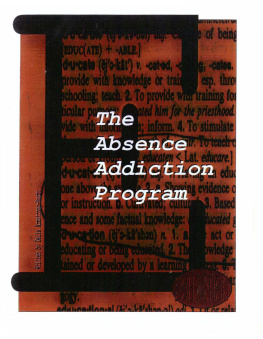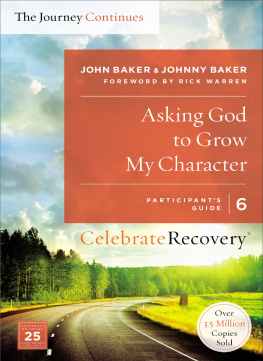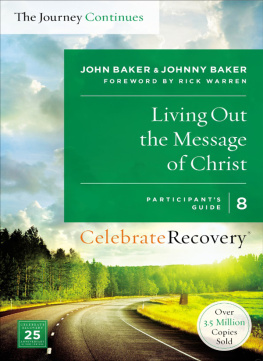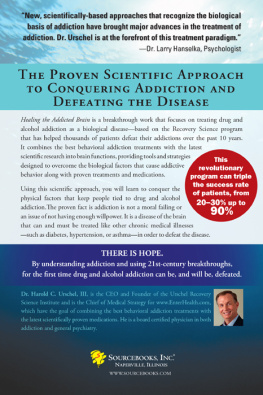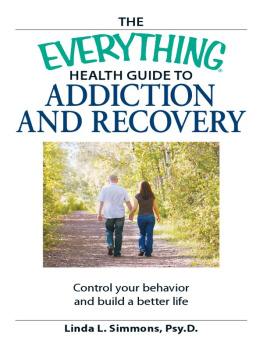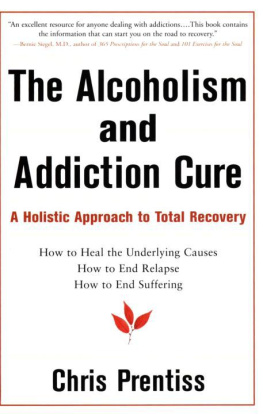Delia Armstrong-Busby - The Absence Addiction Program
Here you can read online Delia Armstrong-Busby - The Absence Addiction Program full text of the book (entire story) in english for free. Download pdf and epub, get meaning, cover and reviews about this ebook. year: 2017, publisher: Adventures in Learning K-12 Inc, genre: Home and family. Description of the work, (preface) as well as reviews are available. Best literature library LitArk.com created for fans of good reading and offers a wide selection of genres:
Romance novel
Science fiction
Adventure
Detective
Science
History
Home and family
Prose
Art
Politics
Computer
Non-fiction
Religion
Business
Children
Humor
Choose a favorite category and find really read worthwhile books. Enjoy immersion in the world of imagination, feel the emotions of the characters or learn something new for yourself, make an fascinating discovery.
- Book:The Absence Addiction Program
- Author:
- Publisher:Adventures in Learning K-12 Inc
- Genre:
- Year:2017
- Rating:4.5 / 5
- Favourites:Add to favourites
- Your mark:
- 100
- 1
- 2
- 3
- 4
- 5
The Absence Addiction Program: summary, description and annotation
We offer to read an annotation, description, summary or preface (depends on what the author of the book "The Absence Addiction Program" wrote himself). If you haven't found the necessary information about the book — write in the comments, we will try to find it.
The Absence Addiction Program is a proven platform for student success. The educational principles that underpin this book assists the success of a diverse student population that is the face of America.
The Absence Addiction Program outcomes demonstrates that all children can succeed and attain the highest levels of their potential regardless of economics, zipcodes, or the range of ethnicity and culture that is America.
The Absence Addiction Program — read online for free the complete book (whole text) full work
Below is the text of the book, divided by pages. System saving the place of the last page read, allows you to conveniently read the book "The Absence Addiction Program" online for free, without having to search again every time where you left off. Put a bookmark, and you can go to the page where you finished reading at any time.
Font size:
Interval:
Bookmark:

Publisher: Adventures In Learning K12 Inc
email:
P.O. Box 10383
80932
ISBN: 9781386387282
I am convinced that the cycle of self-destructiveness can be ameliorated even when family cannot be available. I have many years of personal and professional experience to back up my belief that self-defeating cycles can be interrupted with the help of other significant people in a persons life. Breaking cycles is not about blaming others. Its about utilizing whatever healthy resources are available; its about not being engulfed and consumed by victimization; its about realizing ones dreams for success in spite of obstacles.
All human beings have the right to have a chance at life and the opportunity to break out of self-defeating patterns as early in their lives as possible. Ms. Armstrong-Busbys workbook is about providing this opportunity and chance at a productive life.
This workbook is a powerful tool to assist in breaking self-defeating patterns of absenteeism. Its about realizing the potential and unique value of each student. Ms. Armstrong-Busby looks beyond the mask of truancy, to the student who is lost in a sea of confusion and not only needs, but most importantly wants guidance out of the murky waters. This workbook is about hope and faith in our youths and the belief that with a little bit of help from people who care and who spend a significant amount of time with our children, we can help the student break the cycle of school absenteeism, a necessary prerequisite for achieving success in life.
I am very impressed with Ms. Armstrong-Busbys commitment to, and respect for our youths. Through her workbook, she has provided detailed guidance to teachers, counselors, principals, and other school administrators, on ways to break the cycle of self-defeating patterns that some students may unknowingly be caught up in. She challenges educators to dispel their own rigidly held beliefs about who and what contributes to the opportunity for students to become successful. Her paradigm of the Absence Addiction Cycle, is well thought out; and with accuracy, describes how self-esteem and the lack thereof, play a part in the spiral of depression, despair and ultimately apathy. Her intervention strategies are equally well thought out and on target in regards to attacking an insidious problem in our schools today.
Every child deserves a chance at a productive life and an opportunity for success. We all play a part in providing that chance for our youths. The support given by educators and other significant persons in a childs life, is especially important when our children, through no fault of their own, cannot turn to family for support and encouragement. To send the message to our children that it is the sole responsibility of their parents to see that they achieve academic success, is in my belief, blaming the victim and can potentially extinguish their light of hope. This attitude only communicates to the child that he or she must face life on his or her own, without the opportunity to develop effective strategies for facing academic and future lifes challenges.
Without a doubt, Ms. Armstrong-Busbys workbook provides an exceptional model to help insure that our children will not be abandoned if they find themselves in self-defeating patterns. The workbook provides a practical guide for helping the student throughout his or her lifetime.
In summary, the workbook provides challenges and rewards for all who adopt this paradigm for breaking what would become an addictive cycle of self-defeatism.
Let us ail maintain hope for the worlds children. Let us all share a part in the exciting adventure of creating the best next future generation of leaders that we can. Let us all share a part in breaking cycles!
Deborah Nunally-Blowe, Ph.D.
Clinical Psychologist/Writer
The Absence Addiction Program should properly be thought of as a process: a process that allows participants to alter, and eventually abandon dysfunctional behaviors (truancy, academic failure, inappropriate social interactions) in favor of more rewarding pursuits. The change process begins with the participants decision to enter the program. Entry and continuation in the program are voluntary. At the outset, participants decide what behavior needs changing. Absenteeism will be the choice of many. This is the case when the participant realizes that the absences are creating obstacles to personal, academic, and social success. The change process allows the participants to practice new successful behaviors, beginning with regular school and classroom attendance. It also permits participants to practice the skills essential for achieving self-discipline and personal responsibility. Through the practice of healthy, functional behaviors, (regular classroom attendance in the case of chronic truants) and resultant academic success, the participants start to believe in the new identity that comes with practicing success. Their peers and teachers, likewise, begin to see them in a different light; social labels and stigmas that come with being caught up in negative cycles of school behavior no longer seem to fit, and are eventually shed.
The following diagram illustrates the change process:

The Causal Loop: Students addicted to absenteeism are left struggling in a negative cycle. Through the Absence Addiction Program positive cycles can be the reality
Non-attendance can be seen as a starting point for a series of dysfunctional responses, Including apathy, lack of direction/goals, low self-esteem, depression, and academic failure. These responses lead to emotional disconnectedness followed by physical disconnectionin this case, non-attendance. Thus, the addictive cycle is complete: Dysfunctional behavior is both the cause and the effect. The process of replacing the negative cycle with a positive one begins with intervention. The immediate objective of the Program is a behavioral changein this case, increased attendance. The process begins by providing a supportive school setting distinguished by positive interest in the Program participant.
Font size:
Interval:
Bookmark:
Similar books «The Absence Addiction Program»
Look at similar books to The Absence Addiction Program. We have selected literature similar in name and meaning in the hope of providing readers with more options to find new, interesting, not yet read works.
Discussion, reviews of the book The Absence Addiction Program and just readers' own opinions. Leave your comments, write what you think about the work, its meaning or the main characters. Specify what exactly you liked and what you didn't like, and why you think so.

